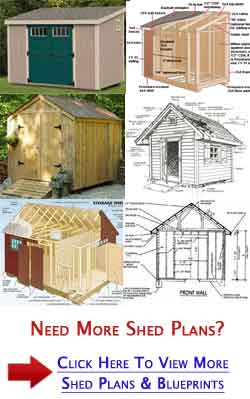

 www.pinterest.com
www.pinterest.com Introduction: Building Your Dream Shed Are you tired of clutter? Do you need extra storage space for your tools, lawn equipment, or hobby supplies? Building your own shed can be a rewarding and cost-effective way to create the storage solution you've always needed. This post provides a detailed, step-by-step guide to help you build your own shed.
Step 1: Planning and Preparation Before you even think about picking up a hammer, careful planning is crucial. This stage involves determining the shed's size and location, obtaining necessary permits, and gathering your materials. Decide on the Size and Design: Consider what you'll be storing in the shed to determine the necessary square footage. Also, think about the style of shed that best complements your property. A simple gable roof shed is a good starting point for beginners. Check Local Building Codes and Obtain Permits: Contact your local municipality to find out about zoning regulations, building codes, and permit requirements for shed construction. Ignoring these requirements can lead to fines or even forced demolition. Create a Detailed Plan: A well-detailed plan will save you time and headaches later on. You can find free shed plans online, purchase pre-made plans, or even create your own using shed design software. Your plan should include dimensions, materials list, and construction details. Gather Your Materials and Tools: Based on your plan, create a comprehensive list of the lumber, hardware, roofing materials, siding, and other supplies you'll need. Also, make sure you have the necessary tools, including a saw, drill, level, measuring tape, hammer, and safety glasses.
Step 2: Foundation Construction The foundation is the backbone of your shed, providing a stable and level base. There are several foundation options, including concrete slabs, gravel pads, and wooden skids. We'll focus on a simple gravel pad foundation. Clear and Level the Site: Remove any vegetation, rocks, or debris from the area where the shed will be located. Use a shovel and rake to level the ground as much as possible. Create a Gravel Pad: Define the perimeter of your shed with stakes and string. Excavate the area to a depth of about 6 inches. Fill the excavated area with compacted gravel, ensuring a level surface. Use a tamper to compact the gravel thoroughly. Optional: Add a Weed Barrier: Lay down a weed barrier fabric over the compacted gravel to prevent weeds from growing up through the foundation.
Step 3: Framing the Floor The floor frame provides a solid platform for the shed's walls and contents. Cut the Floor Joists: Based on your shed plan, cut the floor joists to the appropriate length. Use pressure-treated lumber for the floor frame to resist rot and insect damage. Assemble the Floor Frame: Lay out the floor joists and connect them with rim joists to create a rectangular frame. Use nails or screws to securely fasten the joints. Ensure the frame is square by measuring the diagonals; they should be equal. Install Interior Joists: Space the interior floor joists according to your plan. Typically, they are spaced 16 inches on center (OC). Secure the interior joists to the frame with nails or screws. Attach the Sheathing: Cover the floor frame with plywood or OSB sheathing. Use screws to fasten the sheathing to the floor joists.
Step 4: Building the Walls Framing the walls is where your shed starts to take shape. Cut the Wall Studs: Based on your plan, cut the wall studs to the correct length. Be sure to account for the top and bottom plates. Assemble the Wall Frames: Lay out the wall studs and connect them with top and bottom plates to create rectangular frames. Space the studs 16 inches OC. Remember to frame out any door or window openings according to your plan. Raise the Walls: Carefully lift each wall frame into place and brace it temporarily with wooden supports. Connect the Walls: Use nails or screws to securely fasten the walls together at the corners. Ensure the walls are plumb and square before permanently fastening them.
Step 5: Installing the Roof The roof protects your shed from the elements. Cut the Rafters: Based on your roof design, cut the rafters to the correct length and angle. If you're building a simple gable roof, you'll need to calculate the rafter pitch. Assemble the Rafters: Connect the rafters to form roof trusses. Use gussets or metal connectors to strengthen the joints. Install the Roof Trusses: Lift the roof trusses into place and space them according to your plan. Secure the trusses to the top plates of the walls with nails or screws. Attach Roof Sheathing: Cover the roof trusses with plywood or OSB sheathing. Use screws to fasten the sheathing to the trusses. Install Roofing Material: Cover the sheathing with roofing felt or underlayment to provide a waterproof barrier. Then, install your chosen roofing material, such as asphalt shingles, metal roofing, or wood shakes. Follow the manufacturer's instructions for proper installation.
Step 6: Adding Siding and Finishing Touches With the structure complete, it's time to add siding and finish the shed. Install Siding: Choose your desired siding material, such as wood siding, vinyl siding, or metal siding. Install the siding according to the manufacturer's instructions. Install Doors and Windows: Install the doors and windows according to the manufacturer's instructions. Be sure to properly flash the openings to prevent water damage. Add Trim: Install trim around the doors, windows, and corners of the shed to give it a finished look. Paint or Stain: Apply a coat of paint or stain to the siding and trim to protect the wood and enhance the appearance of the shed.
Conclusion: Enjoy Your New Shed! Congratulations! You've successfully built your own shed. Take a moment to admire your handiwork and enjoy the extra storage space you've created. Remember to periodically inspect your shed for any signs of damage and perform routine maintenance to keep it in good condition for years to come.
Modern Sheds
10' X 12' Shed With 4' Porch
 www.pinterest.com
www.pinterest.com Sheds With Covered Porches — The Shed Shop Usa



0 komentar:
Posting Komentar